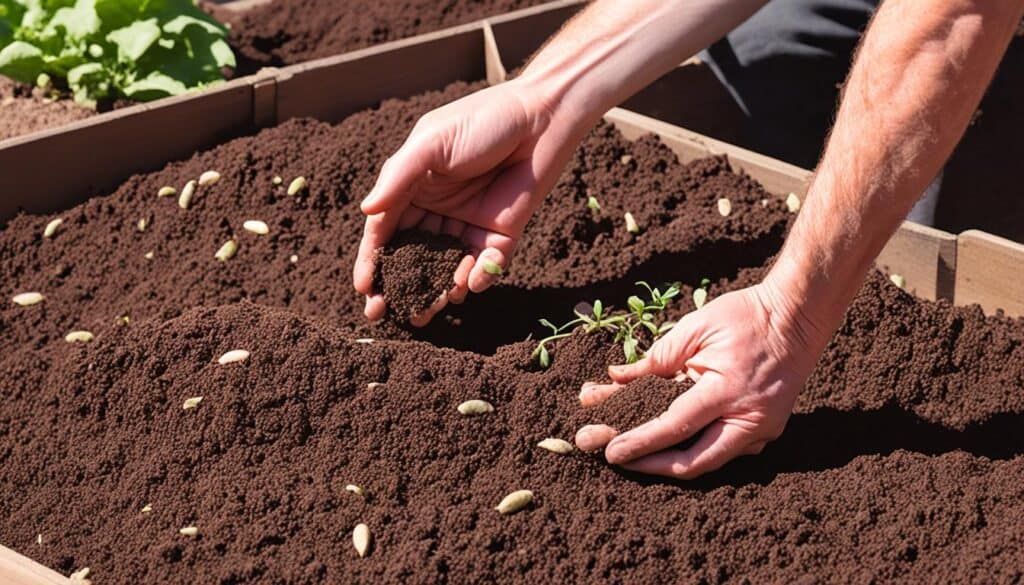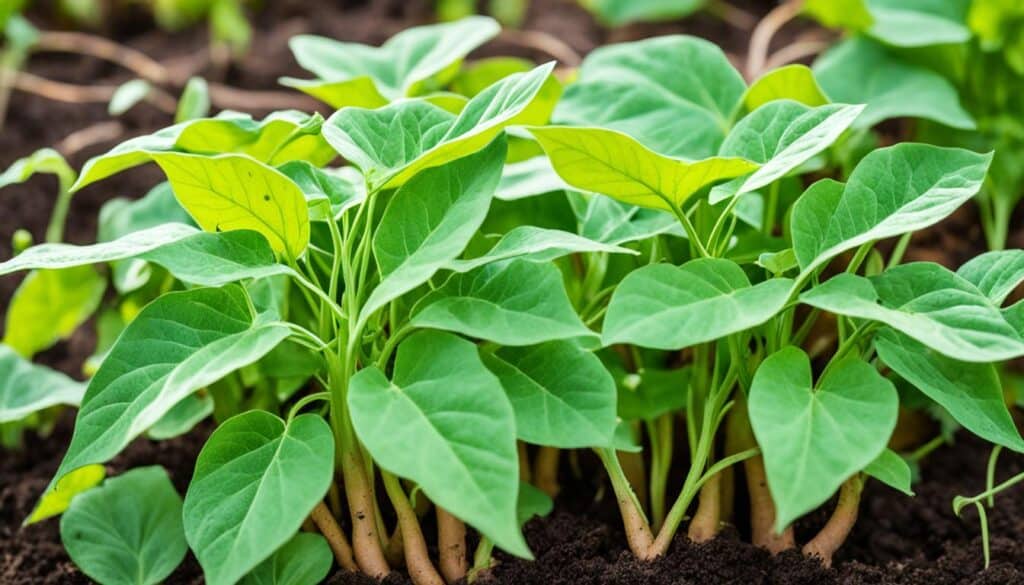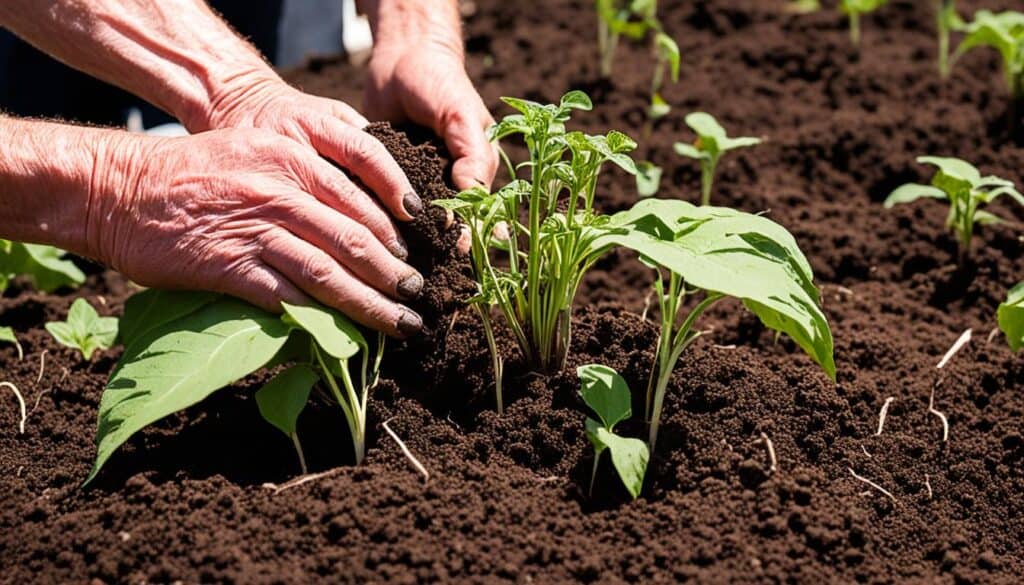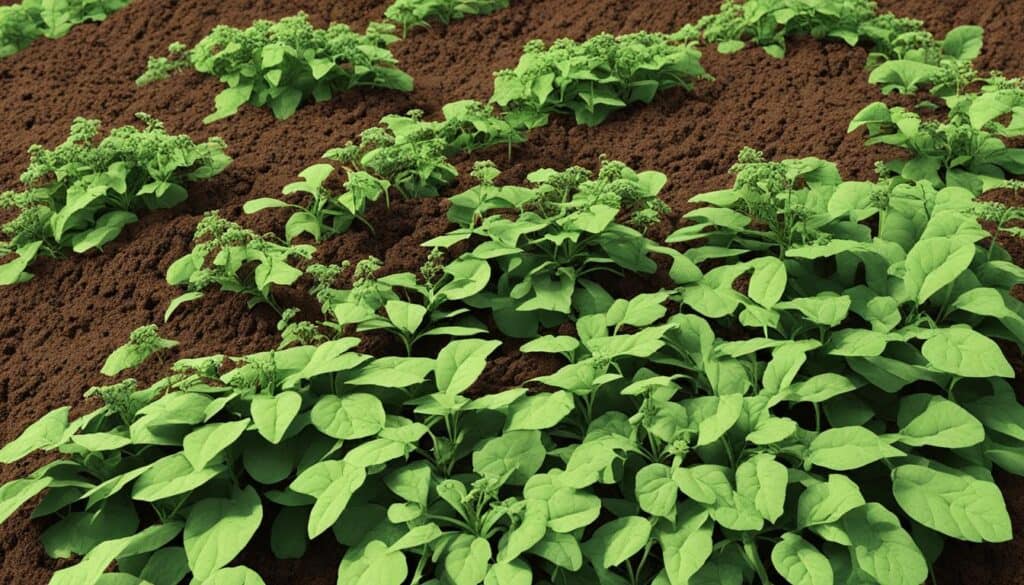Did you know that sweet potatoes were a main source of nourishment for Native Americans and soldiers during the Revolutionary War? These nutritionally rich crops have a fascinating history and are a favorite in many households today. If you’re interested in growing your own sweet potatoes from seeds, this article is the ultimate guide to help you achieve success!
Whether you’re looking for organic sweet potato seeds, heirloom varieties, or simply the best sweet potato seeds for your garden, this growing guide will provide you with all the information you need. From choosing the right varieties to planting and maintaining your sweet potato plants and harvesting a bountiful crop, I’ll cover everything step-by-step.
Get ready to delve into the wonderful world of sweet potato cultivation as we explore the nutrition and health benefits of these vibrant crops, tips for choosing the right sweet potato varieties, best practices for soil preparation, and much more. By the end of this article, you’ll have the knowledge and confidence to grow your own delicious sweet potatoes!
Key Takeaways:
- Sweet potatoes were a main source of nourishment for Native Americans and soldiers during the Revolutionary War.
- This growing guide provides step-by-step instructions for successfully growing sweet potatoes from seeds.
- Explore the nutrition and health benefits of sweet potatoes and learn how to choose the right varieties for your garden.
- Discover best practices for soil preparation, planting and maintaining sweet potato plants, and harvesting and storing your crop.
- By following this guide, you’ll have the knowledge and confidence to grow your own delicious sweet potatoes!
Nutrition and Health Benefits of Sweet Potatoes
Sweet potatoes are not only delicious but also packed with a wide range of nutrients that can greatly benefit your health. They are a nutritious addition to any diet, providing an array of vitamins, minerals, and antioxidants.
The vibrant orange flesh of some sweet potato varieties is a clear indication of their high beta-carotene content, which the body converts into vitamin A. Vitamin A is essential for maintaining good vision, supporting immune function, and promoting healthy skin. In fact, a medium-sized sweet potato can provide more than double the daily recommended intake of vitamin A.
Sweet potatoes are also rich in other vitamins, such as vitamin C, which plays a vital role in immune function and collagen synthesis. Additionally, they are a good source of calcium for bone health and potassium for maintaining healthy blood pressure levels.
The nutritional profile of sweet potatoes doesn’t end there. They are loaded with antioxidants that help protect your body against cellular damage caused by harmful free radicals. These antioxidants, such as beta-carotene and anthocyanins, have been linked to a lower risk of chronic diseases, including heart disease and certain types of cancer.
Furthermore, sweet potatoes are a great source of dietary fiber, which promotes a healthy digestive system and can help regulate blood sugar levels. Their natural sweetness also makes them a satisfying and nutritious option for those looking to satisfy their sweet tooth in a healthier way.
As you can see, sweet potatoes are not only delicious but also offer a wide range of health benefits. Whether you enjoy them baked, mashed, or roasted, incorporating sweet potatoes into your diet can be a rewarding choice for your overall well-being.
| Vitamins | Minerals | Antioxidants |
|---|---|---|
| Vitamin A | Calcium | Beta-carotene |
| Vitamin C | Potassium | Anthocyanins |
Choosing the Right Sweet Potato Varieties
When it comes to sweet potatoes, there is an exciting variety to choose from, each with its own unique taste and appearance. Let’s explore some of the popular sweet potato varieties:
Murasaki Sweet Potatoes
Murasaki sweet potatoes are known for their striking appearance with purple skin and white flesh. These gorgeous tubers provide a delightful twist to the traditional orange varieties, adding a pop of color to your meals. So, if you’re looking to experiment with something different, Murasaki sweet potatoes are a fantastic choice.
O’Henry Sweet Potatoes
If you prefer a sweet potato with a creamy texture and a nutty, honey-like flavor, O’Henry is the variety for you. These sweet potatoes have cream-colored tubers and golden flesh that is stringless, making them ideal for recipes where texture is essential. Experience a unique taste sensation with O’Henry sweet potatoes.
Sweet Potato Bush Porto Rico
Sweet Potato Bush Porto Rico is perfect for those with limited garden space. This compact, bush-type plant produces small runners, allowing you to maximize your cultivation in small areas. Don’t be fooled by its size, as it still yields plentiful, delicious tubers. If you want to grow your sweet potatoes in containers or have a smaller garden, Sweet Potato Bush Porto Rico is the ideal choice.
With these diverse sweet potato varieties in your garden, you’ll have the pleasure of experimenting with flavors and adding vibrant colors to your meals.
Planting and Growing Sweet Potato Seeds
Planting sweet potato seeds, also known as slips, is an exciting and rewarding experience. To ensure successful growth, it is important to create the right growing environment and follow proper planting techniques. Here are some essential steps to get you started:
Preparing the Growing Environment
Sweet potatoes thrive in warm environments with nutrient-rich soil. Start by choosing a planting site that receives full sun exposure. Prepare the soil by building mounds or ridges spaced 3 to 4 feet apart. Incorporate plenty of compost into the soil to provide essential nutrients that will support the growth of your sweet potatoes.
Proper Spacing and Planting
When it comes to spacing, sweet potato slips should be placed 12 to 18 inches apart. Ensure that only about half an inch of the stem is above the soil surface, gently covering the slips with soil.
Watering and Care
Watering is crucial for the successful growth of sweet potatoes, especially during hot and dry periods. Keep the soil consistently moist, but avoid overwatering, as it can lead to root rot. Deep watering is recommended to promote healthy root development.
“Watering is crucial for the successful growth of sweet potatoes.”
Harvesting Sweet Potatoes
As your sweet potato plants mature, the leaves will start to turn yellow. This is a sign that the tubers are ready for harvest. Carefully dig around the plants to avoid damaging them and gently lift the tubers from the soil. Enjoy the satisfaction of harvesting your homegrown sweet potatoes!
“As your sweet potato plants mature, the leaves will start to turn yellow.”
In summary, planting and growing sweet potato seeds require attention to detail and the right growing environment. By following these steps, you can ensure a successful harvest of delicious and nutritious sweet potatoes.
Maintaining and Cultivating Sweet Potato Plants
Once sweet potato plants are established, they require minimal maintenance. Here are some essential tasks to help you maintain healthy and productive sweet potato plants:
Weeding
Regularly remove weeds from the sweet potato bed to prevent competition for nutrients and water. Weeds can hinder the growth of your sweet potato plants and reduce their productivity. A well-maintained weed-free bed will ensure that your sweet potatoes receive the nutrients they need to thrive.
Fertilizing
Apply additional fertilizer about a month after planting to ensure optimal growth. A balanced organic fertilizer will provide the necessary nutrients for your sweet potato plants. Follow the instructions on the fertilizer package for proper application rates and techniques.
Watering
Water your sweet potato plants regularly to keep the soil evenly moist. Avoid overwatering, as excessive moisture can lead to rotting of the tubers. Adequate watering is especially crucial during dry periods or when the weather is hot. Monitor the moisture level of the soil and adjust your watering schedule accordingly.
Pests
Keep an eye out for common pests that can affect sweet potato plants, such as voles and deer. Voles can damage the tubers underground, so take measures to control their population, such as installing barriers or traps. Deer may feed on the foliage, so consider using fences or deterrents to protect your plants.
Pruning
In general, sweet potato plants do not require pruning. They naturally produce sprawling vines that serve as protection for the developing tubers. Avoid excessive pruning, as it can disrupt the plant’s growth and limit tuber production.
By maintaining your sweet potato plants through regular weeding, proper fertilization, watering, pest control, and minimal pruning, you will ensure a healthy and abundant harvest of sweet potatoes.
Harvesting and Storing Sweet Potatoes
When it comes to harvesting sweet potatoes, timing is crucial. These delicious tubers are usually ready for harvest in around 3 to 5 months after planting. To determine if they’re ripe, look for signs such as the vines stop growing and the roots reaching a desirable size.
Once you’ve identified the right time to harvest, carefully remove the soil from around the roots using a garden fork or shovel. Be gentle to avoid causing any damage.
To enhance the flavor and extend the storage life of sweet potatoes, it’s important to cure them. Curing involves exposing the sweet potatoes to specific temperature and humidity conditions to develop their sugars and improve flavor.
My recommended curing process involves placing the sweet potatoes in a warm and humid environment for about 10 days. The ideal conditions are 80-85°F temperature and 85-90% relative humidity. You can use a dedicated curing room or create a makeshift curing space using a box lined with moist burlap or paper towels to maintain the desired humidity.
Proper storage is essential for keeping your sweet potatoes fresh for as long as possible. Ideally, they should be stored in a cool environment with temperatures ranging from 55-60°F. The storage area should also have high humidity to prevent the sweet potatoes from drying out.
Here’s a summary of the key points for harvesting and storing sweet potatoes:
- Harvest sweet potatoes when the vines stop growing and the roots have reached a desirable size.
- Carefully remove soil from around the roots to avoid damaging them.
- Cure sweet potatoes in a warm and humid environment for about 10 days.
- Store cured sweet potatoes in a cool (55-60°F) and humid environment to prevent spoilage.
| Harvesting and Storing Sweet Potatoes |
|---|
Best Practices for Soil Preparation
Sweet potatoes thrive in fertile, well-drained soil with a pH of 5.5-6.5. To ensure optimal growing conditions, it’s important to prepare the soil before planting. Here are some best practices for soil preparation:
1. Adding Compost or Well-Aged Manure
Before planting sweet potatoes, enrich the soil with organic matter such as compost or well-aged manure. These amendments will improve soil structure, provide essential nutrients, and enhance moisture retention.
2. Building Raised Beds or Mounds
In areas with compact or heavy clay soil, consider building raised beds or mounds of topsoil. Raised beds not only promote better drainage but also make it easier to control weeds and ensure optimal root development for sweet potatoes.
3. Using Black Plastic Mulch
In cooler climates, the use of black plastic mulch can be beneficial for sweet potato cultivation. The mulch helps increase and maintain soil temperatures above 65°F, providing the warm environment that sweet potatoes thrive in.
By following these best practices for soil preparation, you’ll create the ideal planting site for sweet potatoes. The enriched soil, improved drainage, and optimal temperature conditions will support healthy plant growth and maximize your harvest.
Tips for Planting Sweet Potato Slips
When it comes to planting sweet potato slips, there are a few key factors to keep in mind to ensure optimal growth and a bountiful harvest. Here are my top tips:
Plant in Warm Soil
A crucial step in planting sweet potato slips is to choose the right time and temperature. Ideally, the soil should be around 65°F (18°C) when planting. It’s best to plant the slips as soon as possible after receiving them to ensure they have the best chance of establishing themselves in the warm soil.
Optimal Spacing
Give your sweet potato slips enough room to grow by spacing them properly. Plant the slips 12-15 inches apart in rows that are 36 inches apart. This spacing allows the plants to receive adequate sunlight, air circulation, and nutrients from the soil.
Protect from Hot Conditions
Planting sweet potato slips in the evening or on overcast days can help protect them from the heat and intense sunlight. This prevents the slips from wilting and ensures they have a better chance of taking root and thriving in the optimal temperature range.
Watering for Root Growth
Water the newly planted sweet potato slips generously for 7-10 days after planting to encourage root growth. This initial watering period helps the slips establish themselves in the soil and develop a strong foundation. Make sure to provide a deep watering, allowing the water to reach the roots.
Mulch for Moisture Retention
Apply a layer of mulch around the sweet potato slips to help retain moisture in the soil and suppress weed growth. Mulching also helps regulate soil temperature, which is beneficial for sweet potatoes. Organic materials such as straw or wood chips make excellent mulch choices.
By following these tips, you’ll be well on your way to successfully planting sweet potato slips and enjoying a rewarding harvest. The next section will cover common pests and how to control them to protect your sweet potato crop.
Common Pests and Pest Control Methods
Sweet potatoes are generally not heavily impacted by pests, especially in northern regions. However, there are a few pests that can cause issues. Voles, deer, and wireworms are the most common sweet potato pests that gardeners may encounter. Understanding these pests and implementing effective control methods can help protect your sweet potato crop.
Voles
Voles are small rodents that can eat the sweet potato crop underground without being noticed. These pests can cause significant damage to the roots and tubers, leading to stunted growth and reduced yields. To control voles:
- Remove any nearby vegetation, debris, or mulch that can provide them with cover.
- Set up vole traps or bait stations around the perimeter of your sweet potato bed.
- Regularly monitor and check the traps for captured voles.
Deer
Deer may be attracted to the foliage of sweet potato plants, posing a threat to your crop. To deter deer:
- Install row covers or use netting to create a physical barrier around your sweet potato plants.
- Consider using electric fencing to prevent deer from accessing your garden.
- Plant companion plants that deer find unappealing, such as marigolds or garlic.
Wireworms
Wireworms are the larvae of click beetles and can be a problem in soil that previously had sod, as they have a two-year life cycle. These pests feed on sweet potato roots, causing damage and reducing plant vigor. To control wireworms:
- Till the soil before planting to expose wireworms to predators and unfavorable conditions.
- Apply beneficial nematodes to the soil, as they can help control wireworm populations.
- Rotate crops to break the wireworm life cycle and reduce their numbers over time.
If you’re experiencing persistent pest issues with your sweet potatoes, it is recommended to contact your local extension agent for guidance and specific control methods suitable for your region. They can provide valuable insights and recommendations to protect your sweet potato crop and other crops in your garden.
Sweet potatoes are generally not heavily impacted by pests, especially in northern regions. However, there are a few pests that can cause issues.
Curing and Storage Recommendations
In order to enhance the flavor and extend the storage life of sweet potatoes, it is important to properly cure them. During the curing process, the starches in sweet potatoes are converted into sugars, resulting in a sweeter and more delicious end product.
There are two recommended methods for curing sweet potatoes:
- Method 1: Curing at 80-85°F and 85-90% relative humidity for about 10 days.
- Method 2: Curing near a furnace at 75°F for 2-3 weeks.
After the curing process, it is important to store sweet potatoes in optimal conditions to maintain their quality. Here are some tips for storing sweet potatoes:
- Temperature: Store sweet potatoes in a cool environment with a temperature between 55-60°F. Avoid storing them in the refrigerator, as the cold temperatures can adversely affect the flavor and texture.
- Humidity: Sweet potatoes prefer high humidity, so it is important to store them in a humid environment. This can be achieved by using storage crates or boxes covered with paper or cloth to retain moisture.
By following these curing and storage recommendations, you can ensure that your sweet potatoes stay fresh and delicious for extended periods of time. Now that you’ve successfully cured and stored your sweet potatoes, you can enjoy their flavors and nutritional benefits in a variety of culinary creations.
Comparing Curing Methods for Sweet Potatoes
| Method | Temperature | Relative Humidity | Duration |
|---|---|---|---|
| Method 1 | 80-85°F | 85-90% | About 10 days |
| Method 2 | Near a furnace at 75°F | N/A | 2-3 weeks |
Conclusion
By following the tips and guidelines in this growing guide, you can have a successful harvest of sweet potato seeds. From choosing the right varieties to preparing the soil, planting the slips, maintaining the plants, and harvesting and storing the sweet potatoes, each step is important for a bountiful crop.
Enjoy the rewards of your hard work by using your homegrown sweet potatoes in a variety of delicious recipes. Whether you roast them, bake them, or make them into fries, sweet potatoes are versatile and nutritious. Their rich flavor and vibrant colors will enhance any meal.
So get your sweet potato seeds and start planting today. With the right knowledge and care, you’ll soon be enjoying a successful harvest of these nutritious and delicious tubers. Happy gardening!










Leave a Reply